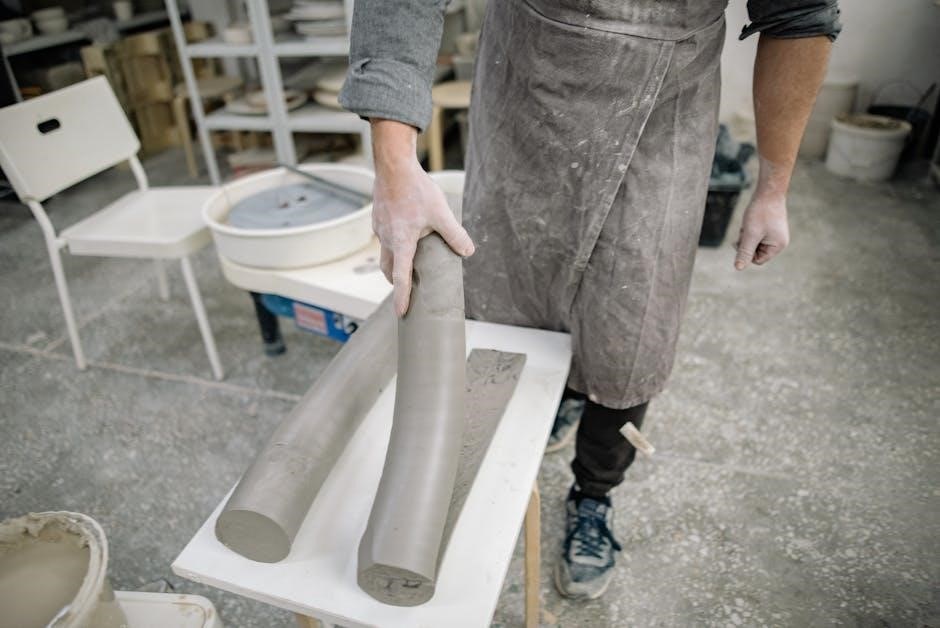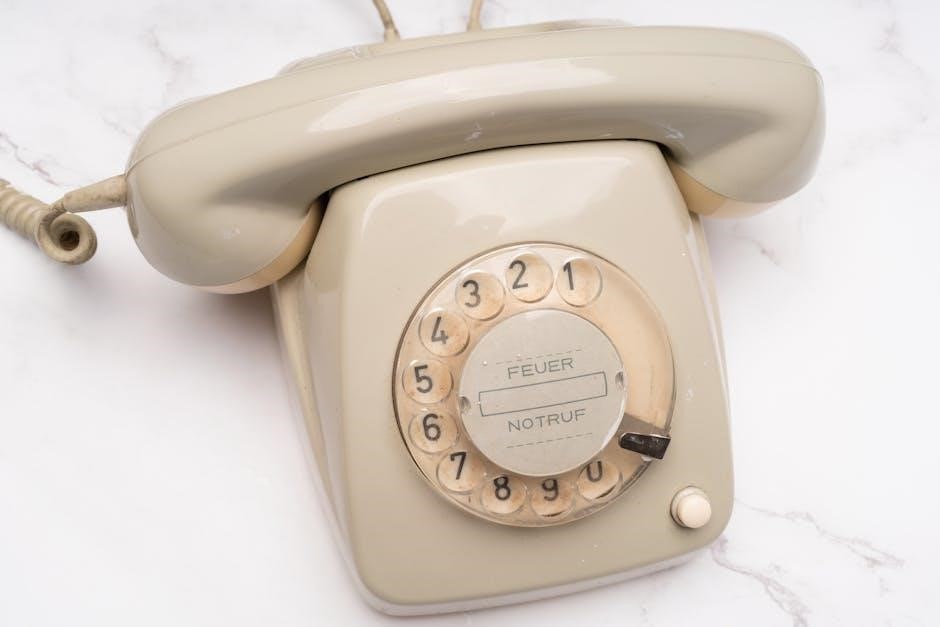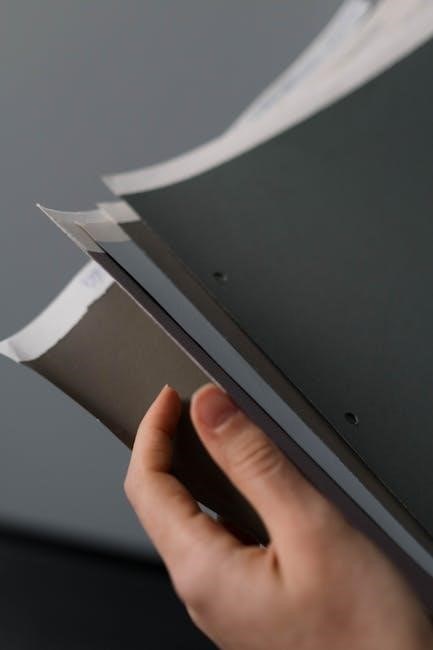
Preparations
1․1 Safety Precautions
Ensure the power to the HVAC system is turned off at the main electrical panel before starting any work․ Handle wires carefully to avoid electrical shock․
1․2 Tools Required
Gather a screwdriver, pliers, wire strippers, and a voltage tester․ These tools are essential for safe and proper thermostat installation and wiring․
1․3 System Compatibility
Verify compatibility with your HVAC system․ The 1F78 works with 24V systems, including gas, oil, electric heat, and heat pumps․ Some millivolt systems require a jumper wire․
Before starting, switch off the power to the HVAC system at the main electrical panel․ Verify the power is off using a voltage tester to avoid electrical shock․ Handle wires carefully to prevent short circuits․ If replacing an old thermostat containing mercury, avoid breaking the mercury cell․ Wear non-absorbent gloves and contain any spilled mercury in a sealed container․ Dispose of mercury-containing components according to local regulations․ Do not touch damaged mercury cells or discard them in household trash․ Follow all instructions carefully to prevent personal injury or property damage․
To install the White Rodgers 1F78 thermostat, gather essential tools: a flathead screwdriver for removing the old thermostat, a Phillips screwdriver for mounting, pliers for wire handling, and wire strippers for trimming wires․ A voltage tester is crucial to ensure the power is off before starting․ Label each wire with the provided tags to maintain organization during the transition․ These tools ensure a safe and efficient installation process, preventing potential electrical issues or misconnections․ Proper preparation with these tools will streamline the replacement and wiring process for your new thermostat․
The White Rodgers 1F78 thermostat is compatible with various HVAC systems, including gas, oil, and electric heat, as well as heat pumps․ It works with standard 24V systems and millivolt systems, requiring a jumper wire for the latter․ The thermostat does not need a common (C) wire for most installations, making it versatile for different setups․ It supports two-wire and three-wire configurations, ensuring compatibility with a wide range of heating and cooling systems․ Always verify your system type to ensure proper installation and operation․

Thermostat Details
The White Rodgers 1F78 thermostat features a simple, non-programmable design with a two-part structure: the cover and base․ It supports 24V and millivolt systems, requiring a jumper wire for the latter, and operates within 0-30VAC, 50/60Hz, handling 0․05-1․0A per terminal․
2․1 Physical Components
The White Rodgers 1F78 thermostat comprises two primary parts: the cover and the base․ The cover is removable for easy access to the internal components, while the base houses the wiring terminals and system controls․ The thermostat includes a jumper wire for compatibility with certain systems and operates within an electrical range of 0-30VAC, 50/60Hz, supporting up to 1․0A per terminal․ Its compact design ensures seamless installation on standard walls, with a user-friendly interface for temperature adjustments and system monitoring․
2․2 Default Settings
The White Rodgers 1F78 thermostat is preconfigured to operate standard heat/cool systems․ It is set to control systems that do not require auxiliary heat activation․ The default cycle rate is set to cycle the system just under 1°F․ With the W905 jumper wire clipped, the cycle rate increases to approximately 1․5°F․ The thermostat is compatible with systems requiring 24VAC power and supports single-stage heating and cooling․ Default settings ensure smooth operation for most HVAC systems, including gas, oil, and electric heat configurations․ These settings can be adjusted based on specific system requirements for optimal performance․
2․3 Key Features
The White Rodgers 1F78 thermostat offers precise temperature control and energy efficiency․ It is non-programmable, making it simple to use for basic heating and cooling needs․ The thermostat features a clear display and straightforward button operations․ It is compatible with a wide range of HVAC systems, including gas, oil, electric heat, and heat pumps․ The 1F78 includes a green backlight for better visibility and supports systems with or without a common wire․ Its default settings ensure optimal performance, while optional jumpers allow customization for specific systems, such as hydronic setups․ This thermostat is designed for reliability and ease of use, making it a practical choice for homeowners․

Removing the Old Thermostat
Shut off power at the main electrical panel․ Remove the thermostat cover and label wires․ Disconnect wires carefully and remove the base and subbase from the wall․
3․1 Steps to Remove the Old Thermostat
Shut off power to the HVAC system at the main electrical panel․ Ensure no power is present before proceeding․
Remove the thermostat cover by gently pulling it straight out or releasing the hinge, depending on the model․
Label each wire with its terminal designation using the labels provided with the new thermostat․
Disconnect the wires one at a time, carefully pulling them away from the old thermostat․ Do not let wires fall back into the wall․
Remove the base by loosening the captive screws․ If a subbase is present, unscrew the mounting screws and detach it from the wall․
Set the old thermostat aside, ensuring wires remain accessible for the new installation․
3․2 Handling Wires and Subbase
After disconnecting the wires, carefully organize them to prevent tangling or damage․ Do not let wires fall back into the wall, as this can complicate installation․ If the old thermostat has a subbase, remove it by unscrewing the mounting screws․ Gently pull the subbase away from the wall or adaptor plate․ Handle wires with care, ensuring no bare sections touch unintended terminals․ If the system uses a mercury-containing thermostat, avoid breaking the mercury cell․ Wear gloves if handling spilled mercury and seal it in a container for proper disposal․ Keep all components organized for the new thermostat installation․
3․3 Disposal Guidelines
Properly dispose of the old thermostat and its components․ If the unit contains mercury, handle it with care․ Do not touch spilled mercury; wear non-absorbent gloves and contain it in a sealed container․ Mercury waste must not be discarded in regular trash․ For mercury-free thermostats, follow local electronic waste disposal regulations․ Recycle the device if possible․ Ensure all parts, including wires and subbase, are disposed of responsibly․ Check local guidelines for hazardous waste collection events or facilities․ Proper disposal helps protect the environment and complies with safety regulations․

Mounting and Wiring
Mount the new thermostat base securely on the wall․ Attach wires to the correct terminals as labeled․ Refer to the wiring diagram for accurate connections․ Ensure compatibility with your HVAC system and verify all wires are properly secured before restoring power․
4․1 Mounting the New Thermostat
Begin by removing the old thermostat base and subbase from the wall․ Install the new thermostat base using the provided screws or existing mounting holes․ Ensure the base is level and securely fastened․ If necessary, attach the adapter plate to accommodate specific system requirements․ Once the base is mounted, align the thermostat cover with the base and gently press until it snaps into place․ Verify that all components are properly seated and the thermostat is stable․ This ensures accurate temperature control and proper system operation․ Follow the manufacturer’s instructions for any additional mounting hardware or adjustments․ Proper installation is critical for reliable performance․
4․2 Wiring Connections
Label each wire from the old thermostat with the terminal designation before disconnecting․ Connect the wires to the corresponding terminals on the new thermostat base․ Ensure all connections are secure and not loose․ For systems requiring a jumper wire, refer to the terminal cross-reference chart in the manual․ Verify that the jumper wire is correctly placed between the specified terminals․ Double-check the wiring diagram for your specific system type (e․g․, heat-only, heat/cool, or heat pump)․ Once all connections are made, tuck the wires neatly into the wall and secure the thermostat base․ Turn the power back on at the main electrical panel and test the system to ensure proper operation․ Follow the manual for any additional wiring configurations specific to your HVAC setup․ Proper wiring is essential for safe and efficient operation․
4․3 Jumper Wire Configuration
The jumper wire configuration ensures proper system operation․ For heat-only systems, connect the jumper between RH and W terminals․ Refer to the terminal cross-reference chart for specific configurations․ The jumper wire is pre-installed for heat/cool systems․ For millivolt or hydronic systems, use the provided RED jumper wire between designated terminals․ Ensure the jumper is securely connected to avoid loose connections․ Incorrect jumper placement can cause system malfunctions․ Double-check the wiring diagram for your system type․ Proper jumper configuration is essential for accurate temperature control and safe operation․ Always refer to the manual for system-specific jumper requirements․ Verify connections before restoring power․

Check Thermostat Operation
After installation, ensure the thermostat functions correctly․ Verify the display shows proper temperature readings․ Test heating and cooling modes to confirm system operation․ Check fan settings and ensure smooth transitions between modes․ Review the display features for clarity and functionality․ Familiarize yourself with the thermostat’s buttons and their operations․ Ensure all programmed settings and schedules work as intended․ Verify energy-saving features are active․ If issues arise, consult the troubleshooting section․ Proper operation ensures energy efficiency and comfort․ Always refer to the manual for detailed operational guidance․ Ensure the system cycles accurately within the specified temperature range․ Confirm the thermostat cover snaps securely onto the base․ Test all features thoroughly before finalizing the setup․
5․1 Initial Setup
After installation, power on the thermostat and ensure the display is active․ Familiarize yourself with the buttons and their functions․ Set the system type (heat, cool, or auto) and configure basic settings like temperature range․ Check the display for clarity and accuracy․ Ensure the thermostat cycles correctly within the specified temperature range․ Verify the fan operation and heating/cooling modes․ Review the energy-saving features and ensure they are activated․ If applicable, set the initial schedule or programming based on your preferences․ Test all functions to confirm proper operation before finalizing the setup․ Proper initial setup ensures optimal performance and efficiency․
5․2 Testing Heating and Cooling
Power on the thermostat and set the system mode to “Heat” or “Cool․” Adjust the temperature setting and observe the display for accuracy․ Ensure the HVAC system responds correctly when the thermostat calls for heat or cool․ Verify the fan operation during heating and cooling cycles․ Check that the system cycles within the specified temperature range (typically 1°F)․ Test the emergency heat function if applicable․ Ensure all electrical connections are secure to prevent malfunctions․ Confirm the thermostat cycles off when the set temperature is reached․ Proper testing ensures reliable performance and energy efficiency․ Follow these steps to verify heating and cooling functionality effectively․
5․3 Understanding Display Features
The thermostat’s display provides essential information, including the current temperature, setpoint, and system mode (Heat, Cool, or Off)․ The green backlight enhances visibility in low-light conditions․ Icons indicate active heating, cooling, or fan operation․ Use the arrow keys to adjust the setpoint, and press “System” to switch modes․ The display also shows the current time and day․ Understanding these features helps optimize temperature control and energy savings․ Familiarize yourself with the display to monitor and adjust settings efficiently․ Proper use ensures the system operates as intended, maintaining comfort and energy efficiency throughout the day and night․

Specifications
6․1 Electrical Data
Electrical rating: 0 to 30 VAC, 50/60 Hz, or DC, with a load capacity of 0․05 to 1․0 Amps per terminal․
6․2 Compatibility Overview
Compatible with 24V systems, including gas, oil, electric heat, and heat pumps․ Works with 2-wire and 3-wire systems, excluding line voltage setups․
6․3 Technical Limits
Maximum system voltage: 30 VAC․ Not suitable for systems exceeding 1․5 Amps or line voltage heating systems like baseboard heaters․
The White Rodgers 1F78 thermostat operates on 0 to 30 VAC, 50/60 Hz, or DC, with a load capacity of 0․05 to 1․0 Amps per terminal․ It is designed for 24V systems, including gas, oil, electric heat, and heat pumps․ The thermostat supports 2-wire and 3-wire configurations but is not compatible with line voltage heating systems (110/240V) or systems exceeding 1․5 Amps․ Ensure the system voltage does not exceed 30 VAC for safe operation․ This device is suitable for standard HVAC systems but may require additional configurations for millivolt or specific hybrid setups․
The White Rodgers 1F78 thermostat is compatible with 24V HVAC systems, including gas, oil, electric heat, and heat pumps․ It supports single-stage heating and cooling systems, as well as millivolt systems when a jumper wire is used; The thermostat works with 2-wire and 3-wire configurations but is not compatible with line voltage (110/240V) systems or those requiring more than 1․5 Amps․ It is suitable for standard heat-only, heat/cool, and certain zone heating setups, ensuring versatility for various residential applications while maintaining energy efficiency and precise temperature control․
The White Rodgers 1F78 thermostat operates on 24V AC/DC systems, with a current range of 0․05 to 1․0 Amps per terminal․ It is not compatible with line voltage (110/240V) systems or applications requiring more than 1․5 Amps․ The thermostat is designed for single-stage heating and cooling systems, excluding multi-stage or zone systems beyond its specified configurations․ It does not support systems exceeding 30VAC or 1․5 Amps, ensuring safe and efficient operation within its design parameters․ These limits ensure optimal performance for standard residential HVAC setups while maintaining compatibility with most common heating and cooling configurations․

Troubleshooting
7․1 Common Issues
The thermostat may not power on, display incorrect temperatures, or fail to activate heating/cooling․ Check for loose wires, incorrect settings, or system incompatibility․
7․2 Advanced Diagnostics
Inspect wiring connections and ensure proper terminal assignments․ Verify the subbase is securely mounted and compatible with your HVAC system for reliable operation․
7․3 Resetting the Thermostat
Reset by removing batteries for 10 seconds or pressing the reset button․ This restores default settings and resolves many operational issues quickly and effectively․
Common issues with the White Rodgers 1F78 thermostat include the system not turning on, incorrect temperature readings, or the thermostat failing to activate heating or cooling․ These problems often arise from loose or improperly connected wires, incorrect system settings, or compatibility issues with the HVAC system․ Users may also experience issues with the display not lighting up, which could indicate a power supply problem or faulty thermostat components․ Additionally, improper jumper wire configurations or outdated software can cause operational inconsistencies․ Addressing these issues typically involves checking wiring connections, ensuring proper system compatibility, and performing a reset or software update as needed․
Advanced diagnostics for the White Rodgers 1F78 thermostat involve checking the wiring configuration and ensuring all connections are secure․ Verify that the jumper wires are correctly set according to the system type, such as heat-only or heat/cool configurations․ Use a multimeter to test voltage levels at the thermostat terminals to ensure proper power supply․ If issues persist, perform a factory reset by removing the batteries and disconnecting the power supply for 30 seconds․ This often resolves software-related glitches․ Additionally, consult the wiring diagram provided in the manual to confirm that all terminals match the system requirements․ If problems remain unresolved, contact technical support for further assistance․
To reset the White Rodgers 1F78 thermostat, remove the batteries and disconnect the power supply for 30 seconds․ This will revert the thermostat to its factory settings․ For systems with a jumper wire, ensure it is correctly configured before restoring power․ After resetting, turn the power back on and test the thermostat by adjusting the temperature settings․ If issues persist, consult the manual or contact technical support for further assistance․ This process ensures the thermostat operates correctly and resolves most software-related issues․

Programming the Thermostat
Program schedules for your White Rodgers 1F78 thermostat by setting desired temperatures for different times of the day․ Adjust cycle rates to optimize energy efficiency and comfort․ Use the energy-saving features to reduce consumption during off-peak hours; Ensure settings align with your daily routine for consistent performance․ Refer to the manual for detailed instructions on customizing your thermostat’s programming options․
8․1 Setting Schedules
The White Rodgers 1F78 thermostat allows you to set desired temperatures for different times of the day․ While it is non-programmable, you can manually adjust settings to maintain comfort and efficiency․ Press the up or down arrows to set your preferred temperature․ The thermostat will maintain this setting until manually changed․ For systems with multiple stages, ensure the thermostat is configured correctly for heating or cooling modes․ Refer to the manual for guidance on optimizing temperature settings for your specific HVAC system․ This straightforward process ensures consistent comfort without advanced programming features․
8․2 Adjusting Cycle Rates
To adjust the cycle rates on your White Rodgers 1F78 thermostat, locate the W905 clip․ This clip, when installed, increases the temperature cycle from 1°F to 1․5°F, improving system efficiency․ For heat-only systems, attach the clip to the RH and W terminals․ For heat/cool systems, attach it to the RH and RC terminals․ This adjustment ensures smoother transitions between heating and cooling cycles․ Properly setting the cycle rate helps maintain consistent temperatures and prevents frequent system starts and stops, optimizing energy use and comfort․ Always refer to the manual for specific configurations tailored to your HVAC setup․
8․3 Energy-Saving Features
The White Rodgers 1F78 thermostat offers energy-saving features to optimize your HVAC system’s performance․ By adjusting the cycle rate with the W905 clip, you can reduce frequent system starts and stops, lowering energy consumption․ The thermostat’s compatibility with heat pumps and electric heat systems ensures efficient operation․ Additionally, the 5-2 day programming option allows you to set schedules that align with your lifestyle, preventing unnecessary heating or cooling when not needed․ Proper installation and configuration of these features can significantly reduce energy usage, helping you save on utility bills while maintaining comfort․ Regular maintenance and updates also support long-term energy efficiency․

Maintenance and Upkeep
9․1 Cleaning the Thermostat
Regularly clean the thermostat cover and base with a soft cloth to ensure proper functionality and prevent dust buildup․ Avoid harsh chemicals or liquids․
9․2 Replacing Batteries
If your thermostat uses batteries, replace them annually or when the display indicates low battery levels․ Use the recommended battery type for optimal performance․
9․3 Software Updates
Check for software updates periodically to ensure your thermostat operates with the latest features and improvements․ Follow the manual’s instructions for updating the firmware․
Regular cleaning ensures optimal performance and extends the lifespan of your White Rodgers 1F78 thermostat․ Gently remove the cover and base, then wipe them with a soft, dry cloth․ Avoid harsh chemicals, liquids, or abrasive materials that could damage the components․ For the display, use a lightly dampened cloth, ensuring no moisture seeps inside․ Clean the buttons and vents to prevent dust buildup, which can interfere with temperature sensing․ Perform this maintenance every 3-6 months or when visible dust accumulates․ Proper cleaning maintains accuracy and reliability in temperature control, ensuring your system operates efficiently year-round․
To replace the batteries in your White Rodgers 1F78 thermostat, first, ensure the system is powered off․ Locate the battery compartment on the back of the thermostat․ Gently pull it straight out from the base․ Remove the old batteries and discard them properly․ Insert two new AAA alkaline batteries, ensuring proper orientation․ Avoid mixing old and new batteries or using rechargeable types․ Replace the compartment securely․ If the display shows a low battery indicator, replacement is necessary to maintain functionality․ Perform this process every 12-24 months or when the low battery alert appears․ Proper battery maintenance ensures continuous and accurate temperature control, preventing system interruptions and ensuring reliable operation․ Always follow safety guidelines when handling batteries to avoid any potential hazards․
Software updates for the White Rodgers 1F78 thermostat are typically not required, as it is a non-programmable model․ However, if updates are available, they may enhance performance or add features․ To update, ensure the thermostat is powered off and disconnect it from the system․ Use a USB connection or jumper wire configuration, as specified in the manual․ Download the latest firmware from the White Rodgers website and follow on-screen instructions․ After updating, restart the thermostat and test its operation․ If issues arise, consult the user manual or contact customer support for assistance․ Regular updates ensure optimal functionality and compatibility with your HVAC system․
Manufacturer Support
White Rodgers offers comprehensive support, including a dedicated customer service hotline, detailed online resources, and a warranty program․ Visit their official website for contact details, troubleshooting guides, and downloadable manuals to ensure optimal thermostat performance․
10․1 Contact Information
For assistance with your White Rodgers 1F78 thermostat, contact their customer service at www․white-rodgers․com․ Call their support hotline at 1-800-284-2925 for technical help․ Email inquiries can be directed to customer․service@white-rodgers․com․ Their team is available Monday-Friday, 8 AM to 5 PM CST, to address installation, troubleshooting, or warranty-related questions․ Visit their website for additional resources, including manuals and FAQs, to resolve common issues promptly and efficiently․
10․2 Warranty Details
The White Rodgers 1F78 thermostat is backed by a limited one-year warranty covering repairs or replacements due to defects in materials or workmanship․ Warranty coverage begins from the date of purchase and applies when the product is used under normal conditions and properly installed․ For warranty claims, contact White Rodgers customer service with proof of purchase․ Damage caused by misuse, tampering, or improper installation is excluded․ The warranty does not cover incidental or consequential damages․ Refer to the official White Rodgers website for full warranty terms and conditions․
10․3 Online Resources
The official White Rodgers website offers comprehensive online resources, including downloadable manuals, troubleshooting guides, and installation instructions for the 1F78 thermostat․ Visit their support page for detailed FAQs, wiring diagrams, and software updates․ Additionally, customer support is available via email or phone for technical assistance․ Users can access the Emerson Climate Technologies portal for advanced diagnostics and repair kits․ Online forums and tutorials provide tips for optimizing thermostat performance and resolving common issues․ Ensure to refer to these resources for accurate and up-to-date information to maintain your thermostat’s efficiency and functionality․
